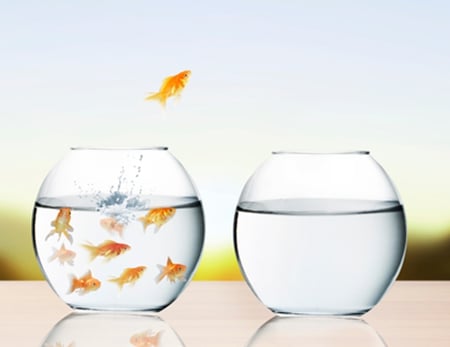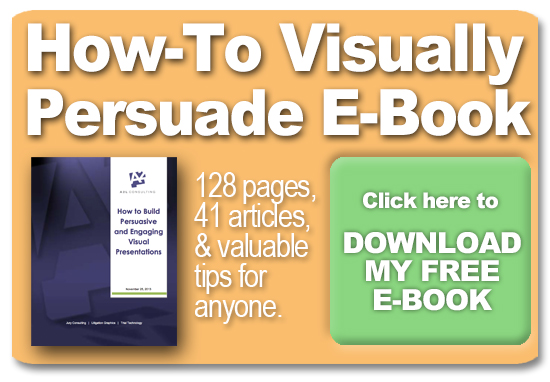by Ken Lopez
Founder/CEO
A2L Consulting
All of a sudden, presenters are waking up to an unfamiliar world. Audiences are demanding more than pretty pictures from their presenters. Now, instead of thinking a presentation is good because it foregos bullet points and instead uses stock photos like the ubiquitous jumping goldfish, audiences are demanding higher quality visuals and more efficiently delivered content.
Let's consider the progression of modern presentations, and I'll offer a view into the near future:
- 1990s - Where it used to be sufficient to talk, visual aids are demanded.
- 2000s - Where it used to be sufficient to use visual aids, electronic PowerPoint presentations are demanded.
- early 2010s - Where it used to be sufficient to use text-heavy PowerPoint slides, less text and more pictures are demanded.
- (the near future) late 2010s - Where it used to be sufficient to use more pictures, visual persuasion is demanded.
No longer are audiences satisfied by the mere conveyance of information, no matter how attractively it is presented. They are demanding more from presenters in two key areas.
First, audiences are demanding high-quality, not just pretty, visuals. We just can't use a few stock images downloaded from Getty or ShutterStock and hope to be persuasive or received well. Using such imagery increasingly feels cheap. One or two stock photos in a presentation works, but one on every other slide is the visual equivalent of using many long block quotes from other authors in an article you "wrote" with an occasional original sentence mixed in. Sure, you've assembled the content, but you're really just repurposing the work of others who are outside of your organization. Instead, create your own visuals. Don't be afraid to take a photo yourself that tells a story. These will land better, allow you use storytelling and be more memorable.
Second, visual efficiency is more important than ever. That does not necessarily mean fewer slides. Rather, it means using clean design that allow the audience to understand your point very quickly, and it means using a charts, images and data to tell stories clearly and quickly. Remember, reading text that is also on screen is a recipe for utter failure. The best idea is to always combine the oral and visual message rather than duplicate the message.
The goal of most presentations is to demand action, whether a sales pitch, a closing argument, a report to a client or an internal presentation. Simply, the goal is to persuade.
How one organizes a presentation can have enormous impact on how it persuades. How well one uses storytelling will affect your outcome. However, how pretty the presentation is will usually not move the needle as much as using science-based persuasion techniques. This is why simply hiring a talented graphic designer to "spruce up" your presentation will make you look more professional, but that work will most likely not affect your overall persuasiveness.
Fundamentally, the lack of connection between pretty graphics and persuasive graphics explains the need for coupling science with design when persuasion is the goal.
Other A2L Consulting articles related to visual persuasion, developing persuasive graphics and the distinction between good graphic design and good persuasive design work:
- What is Visual Persuasion and What Do You Need to Know About It?
- The Magic of a 30:1 Presentation Preparation Ratio
- Litigation Graphics: It's Not a Beauty Contest
- 16 PowerPoint Graphics You Won't Believe Are PowerPoint
- Don't Use PowerPoint as a Crutch in Trial or Anywhere
- Storytelling as a Persuasion Tool Webinar






Leave a Comment